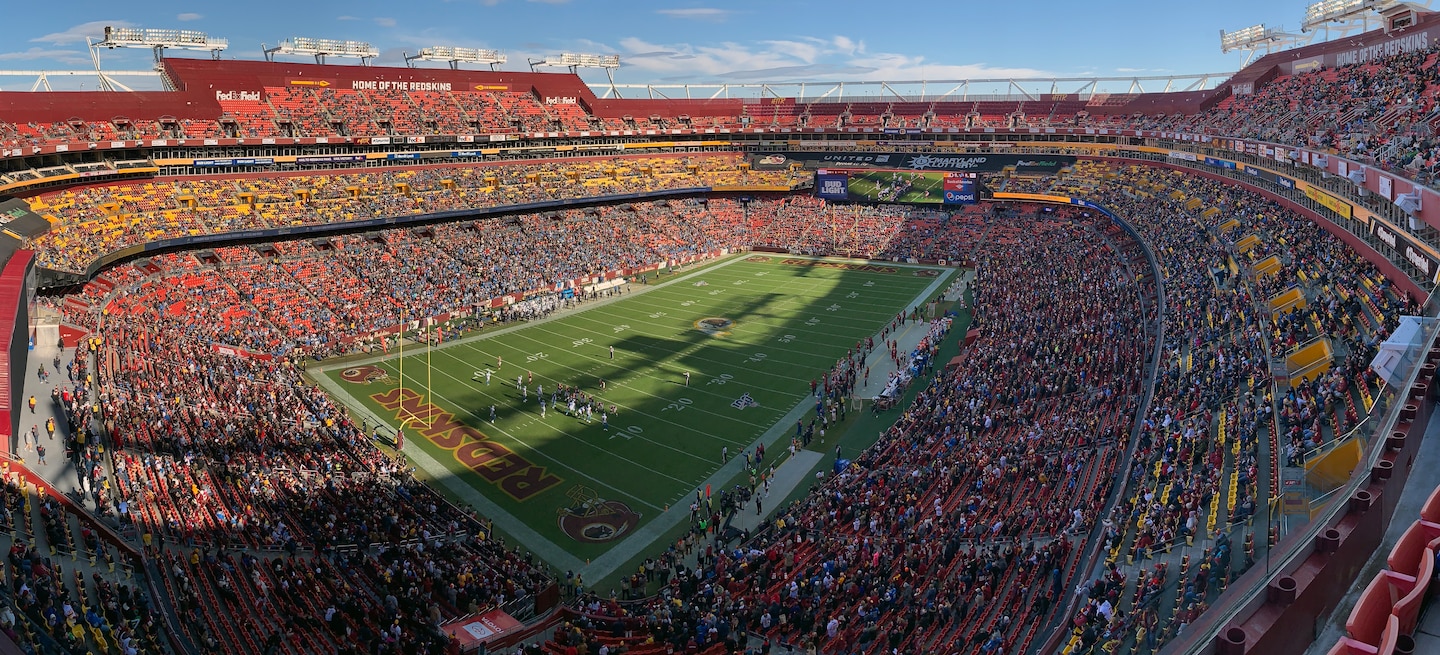D.C.’s 2026 World Cup entry would require removal of some FedEx Field seats

“We’d remove a few rows and cut out the [curved] walls in the corners,” said Sean DeBarbieri, director of communications for the Washington Football Team, which owns the Landover, Md., venue.
The plan to widen the field came to light in a virtual presentation to FIFA last week touting the area’s bid to host a portion of the tournament. In it, the stadium’s width is listed at almost 70 yards, the minimum for a World Cup.
It also listed a proposed girth of 74½ yards, a proper size for the likes of France, Brazil and other titans of the sport.
Because football fields are 20 yards narrower than soccer pitches, however, FedEx Field and some other bidding U.S. stadiums do not have enough space for a wider playing area, plus benches, advertising signage, TV apparatus and a security buffer.
DC2026, the civic and business group overseeing the campaign, would cover the cost of the renovations, which would have to be completed by early 2026.
The 2026 World Cup will be the first time the event is co-hosted by three countries, and it will mark Canada’s first time as a host or co-host.
FIFA will conduct inspection tours in the coming months, then welcome recommendations from the three-nation organizers before announcing its choices sometime next year.
FedEx Field is the weak spot in D.C.’s otherwise strong bid. Erected in 1997, it is notorious for terrible traffic and a staid atmosphere. The NFL team is seeking to build a new stadium, ideally in the District, but it is legally bound to play at FedEx Field through the 2026 season.
A new stadium operating in time for the World Cup has not been ruled out but seems highly unlikely. The District’s RFK Stadium, the site of five World Cup matches in 1994, is scheduled to be razed in 2021.
Greg O’Dell, president and chief executive of EventsDC, the events and sports authority for the city, said the NFL team is on board with the World Cup effort at FedEx Field.
“We recognize we all need to put our best foot forward, and we anticipate and welcome their support that they know that they make sure the venue is ready for play of the caliber of the World Cup,” he said last month.
It’s unclear whether the unspecified number of removed seats would return for the 2026 NFL season.
FedEx Field did not have to make alterations in 1999, when it staged the Women’s World Cup quarterfinal between the United States and Germany.
The venue has also hosted high-end men’s matches involving, among others, the Spanish and Brazilian national teams, FC Barcelona, Real Madrid and Manchester United.
For such exhibitions, the field dimensions do not need to meet strict requirements. Official competition is different. FIFA mandates a length of 110 to 120 yards and a width of 70 to 80 yards for the World Cup.
FedEx Field’s current boundaries are 114.8 by 70. The D.C. bid package proposes the same length and more than four additional yards of width.
Plans also call for the overall area (playing field and additional space) to grow from 130 yards long and 85.3 yards wide to 135.6 and 89.7, respectively.
Fourteen of the other 16 U.S. contenders house NFL teams. The exceptions are, nonetheless, traditional football venues: the Rose Bowl in Pasadena, Calif., and Camping World Stadium in Orlando.
A long shot to make the final cut, Baltimore’s M&T Bank Stadium could gain momentum if FIFA sours on FedEx Field. Baltimore bid leaders did not specify the stadium’s playing dimensions. According to the U.S. bid book, M&T Bank Stadium’s overall area width (76.5 yards) is smaller than FedEx Field’s.
“Currently, we are within midrange of pitch standards/dimensions as required” in the initial bid, said Terry Hasseltine, executive director of the Maryland Sports Commission. “This said, FIFA is reviewing and working to get stadiums to consider and/or meet max standards/dimensions for the pitch. We are currently in discussions and working through what that would look like at M&T Bank Stadium.”
Several other contenders, including Levi’s Stadium in Santa Clara, Calif., and MetLife Stadium in East Rutherford, N.J., have tighter widths than FedEx Field’s.
In 1994, Foxboro Stadium in the Boston suburbs needed to remove seats and cut into corner sections to accommodate the World Cup.
The removal of seats at FedEx Field — combined with reductions for security and other purposes — will leave gross capacity at 62,408, according to the D.C. bid. Minus media and VIP areas, the net capacity is just 55,650.
The stadium once held more than 91,000 before downsizing in the upper deck and other renovations. Last year, the NFL team listed capacity at 82,000.






